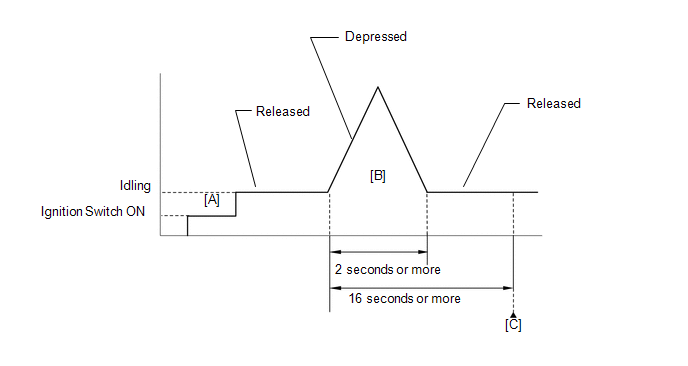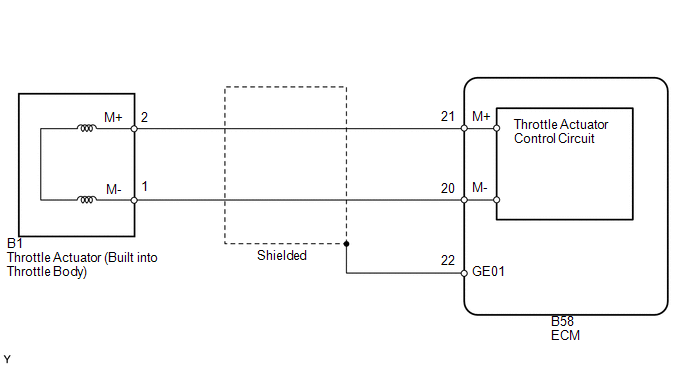Toyota Venza: Throttle Actuator Control Motor Circuit Low (P2102,P2103)
DESCRIPTION
The throttle actuator is operated by the ECM and opens and closes the throttle valve using gears.
The opening angle of the throttle valve is detected by the throttle position sensor, which is mounted on the throttle body. The throttle position sensor provides feedback to the ECM. This feedback allows the ECM to appropriately control the throttle actuator and monitor the throttle opening angle as the ECM responds to driver inputs.
HINT:
This Electronic Throttle Control System (ETCS) does not use a throttle cable.
|
DTC No. |
DTC Detection Condition |
Trouble Area |
|---|---|---|
|
P2102 |
Both of the following conditions continue for 2 seconds (1 trip detection logic): (a) The throttle actuator drive duty ratio is 80% or more. (b) The throttle actuator current is below 0.5 A. |
|
|
P2103 |
Either of the following conditions is met (1 trip detection logic):
|
|
MONITOR DESCRIPTION
The ECM monitors the electrical current through the electronic actuator, and detects malfunctions and open circuits in the throttle actuator based on this value. If the current is outside the standard range, the ECM determines that there is a malfunction in the throttle actuator. In addition, if the throttle valve does not function properly (for example, stuck on), the ECM determines that there is a malfunction. The ECM then illuminates the MIL and stores a DTC.
- Example:
- When the electrical current is below 0.5 A and the throttle actuator duty ratio exceeds 80%, the ECM interprets this as the current being outside the standard range, illuminates the MIL and stores a DTC.
MONITOR STRATEGY
|
Related DTCs |
P2102: Electronic Throttle Actuator Control Motor Range Check (Low Current) P2103: Electronic Throttle Actuator Control Motor Range Check (High Current) |
|
Required Sensors/Components (Main) |
Throttle actuator (throttle body) |
|
Required Sensors/Components (Related) |
None |
|
Frequency of Operation |
Continuous |
|
Duration |
P2102: 2 seconds P2103 (Case 1): 25 times P2103 (Case 2): 0.6 seconds |
|
MIL Operation |
Immediate |
|
Sequence of Operation |
None |
TYPICAL ENABLING CONDITIONS
All|
Monitor runs whenever the following DTCs are not stored |
None |
|
All of the following conditions are met |
- |
|
Command to electronic throttle actuator |
ON |
|
Output duty cycle |
80% or more |
|
Electronic throttle actuator power supply voltage |
8 V or higher |
|
Motor current change during last 0.016 seconds |
Below 0.2 A |
|
All of the following conditions are met |
- |
|
Command to electronic throttle actuator |
ON |
|
Either of the following conditions is met: |
1 or 2 |
|
1. Electronic throttle actuator power supply voltage |
8 V or higher |
|
2. Command to electronic throttle actuator power |
ON |
|
Battery voltage |
8 V or more |
|
Starter |
Off |
TYPICAL MALFUNCTION THRESHOLDS
P2102|
Monitor current |
Below 0.5 A |
|
Motor driver IC high current limiter monitor input |
Fail |
|
Motor driver IC high current inhibit signal |
ON |
CONFIRMATION DRIVING PATTERN

- Connect the Techstream to the DLC3.
- Turn the ignition switch to ON and turn the Techstream on.
- Clear the DTCs (even if no DTCs are stored, perform the clear DTC procedure)
(See page
.gif) ).
). - Turn the ignition switch off and wait for at least 30 seconds.
- Turn the ignition switch to ON and turn the Techstream on [A].
- Start the engine.
- With the vehicle stationary, fully depress the accelerator pedal and quickly release it [B].
- Check that 16 seconds or more have elapsed from the instant when the accelerator pedal is first depressed.
- Enter the following menus: Powertrain / Engine / Trouble Codes [C].
- Read the Pending DTCs.
HINT:
- If a pending DTC is output, the system is malfunctioning.
- If a pending DTC is not output, perform the following procedure.
- Enter the following menus: Powertrain / Engine / Utility / All Readiness.
- Input the DTC: P2102 or P2103.
- Check the DTC judgment result.
Techstream Display
Description
NORMAL
- DTC judgment completed
- System normal
ABNORMAL
- DTC judgment completed
- System abnormal
INCOMPLETE
- DTC judgment not completed
- Perform driving pattern after confirming DTC enabling conditions
N/A
- Unable to perform DTC judgment
- Number of DTCs which do not fulfill DTC preconditions has reached ECU memory limit
HINT:
- If the judgment result shows NORMAL, the system is normal.
- If the judgment result shows ABNORMAL, the system has a malfunction.
- If the judgment result shows INCOMPLETE or N/A, perform steps [B] through [C] again.
- If no pending DTC is output, perform a universal trip and check for
permanent DTCs (See page
.gif) ).
).
HINT:
- If a permanent DTC is output, the system is malfunctioning.
- If no permanent DTC is output, the system is normal.
FAIL-SAFE
When either of these DTCs, as well as other DTCs relating to ETCS (Electronic Throttle Control System) malfunctions, is stored, the ECM enters fail-safe mode. During fail-safe mode, the ECM cuts the current to the throttle actuator, and the throttle valve is returned to a 6° throttle angle by the return spring. The ECM then adjusts the engine output by controlling the fuel injection (intermittent fuel-cut) and ignition timing, in accordance with the accelerator pedal opening angle, to allow the vehicle to continue running at a minimal speed. If the accelerator pedal is depressed firmly and gently, the vehicle can be driven slowly.
Fail-safe mode continues until a pass condition is detected, and the ignition switch is then turned off.
WIRING DIAGRAM

CAUTION / NOTICE / HINT
HINT:
Read freeze frame data using the Techstream. The ECM records vehicle and driving condition information as freeze frame data the moment a DTC is stored. When troubleshooting, freeze frame data can help determine if the vehicle was moving or stationary, if the engine was warmed up or not, if the air fuel ratio was lean or rich, and other data from the time the malfunction occurred.
PROCEDURE
|
1. |
INSPECT THROTTLE BODY (RESISTANCE OF THROTTLE ACTUATOR) |
(a) Inspect the throttle body (See page .gif) ).
).
HINT:
Perform "Inspection After Repair" after replacing the throttle body (See page
.gif) ).
).
| NG | .gif) |
REPLACE THROTTLE BODY |
|
|
2. |
CHECK HARNESS AND CONNECTOR (THROTTLE BODY - ECM) |
(a) Disconnect the throttle body connector.
(b) Disconnect the ECM connector.
(c) Measure the resistance according to the value(s) in the table below.
Standard Resistance (Check for Open):
|
Tester Connection |
Condition |
Specified Condition |
|---|---|---|
|
B1-2 (M+) - B58-21 (M+) |
Always |
Below 1 Ω |
|
B1-1 (M-) - B58-20 (M-) |
Always |
Below 1 Ω |
Standard Resistance (Check for Short):
|
Tester Connection |
Condition |
Specified Condition |
|---|---|---|
|
B1-2 (M+) or B58-21 (M+) - Body ground |
Always |
10 kΩ or higher |
|
B1-1 (M-) or B58-20 (M-) - Body ground |
Always |
10 kΩ or higher |
| NG | .gif) |
REPAIR OR REPLACE HARNESS OR CONNECTOR |
|
|
3. |
INSPECT THROTTLE BODY (VISUALLY CHECK THROTTLE VALVE) |
(a) Check for foreign objects between the throttle valve and the housing.
OK:
No foreign objects between the throttle valve and housing.
HINT:
Perform "Inspection After Repair" after cleaning the throttle body (See page
.gif) ).
).
| NG | .gif) |
REMOVE FOREIGN OBJECT AND CLEAN THROTTLE BODY |
|
|
4. |
INSPECT THROTTLE BODY (THROTTLE VALVE) |
(a) Check if the throttle valve opens and closes smoothly.
OK:
Throttle valve opens and closes smoothly.
HINT:
Perform "Inspection After Repair" after replacing the throttle body (See page
.gif) ).
).
| OK | .gif) |
REPLACE ECM |
| NG | .gif) |
REPLACE THROTTLE BODY |
 Intake Manifold Runner Position Sensor / Switch Circuit (Bank 1) (P2014,P2016,P2017)
Intake Manifold Runner Position Sensor / Switch Circuit (Bank 1) (P2014,P2016,P2017)
DESCRIPTION
The tumble control valve position sensor is a non-contact type sensor.
The position sensor measures the opening angle of the tumble control valve. The
sensor is reliable and accurate, ...
 Throttle / Pedal Position Sensor "A" Minimum Stop Performance (P2109)
Throttle / Pedal Position Sensor "A" Minimum Stop Performance (P2109)
DESCRIPTION
The idle speed is controlled by the Electronic Throttle Control System (ETCS).
The ETCS is comprised of a throttle actuator, which operates the throttle valve,
and a throttle position ...
Other materials about Toyota Venza:
Data List / Active Test
DATA LIST / ACTIVE TEST
1. DATA LIST
HINT:
Using the Techstream to read the Data List allows the values or states of switches,
sensors, actuators and other items to be read without removing any parts. This non-intrusive
inspection can be very useful bec ...
Terminals Of Ecu
TERMINALS OF ECU
1. A/C AMPLIFIER
HINT:
Check from the rear of the connector while it is connected to the A/C amplifier.
Terminal No.
(Symbol)
Wiring Color
Terminal Description
Condition
Specified ...
Inspection
INSPECTION
PROCEDURE
1. INSPECT FRONT OIL PUMP AND GEAR BODY SUB-ASSEMBLY
(a) Turn the drive gear with 2 screwdrivers and make sure that it rotates
smoothly.
NOTICE:
Be careful not to damage the oil seal lip.
...
0.1679

.gif)